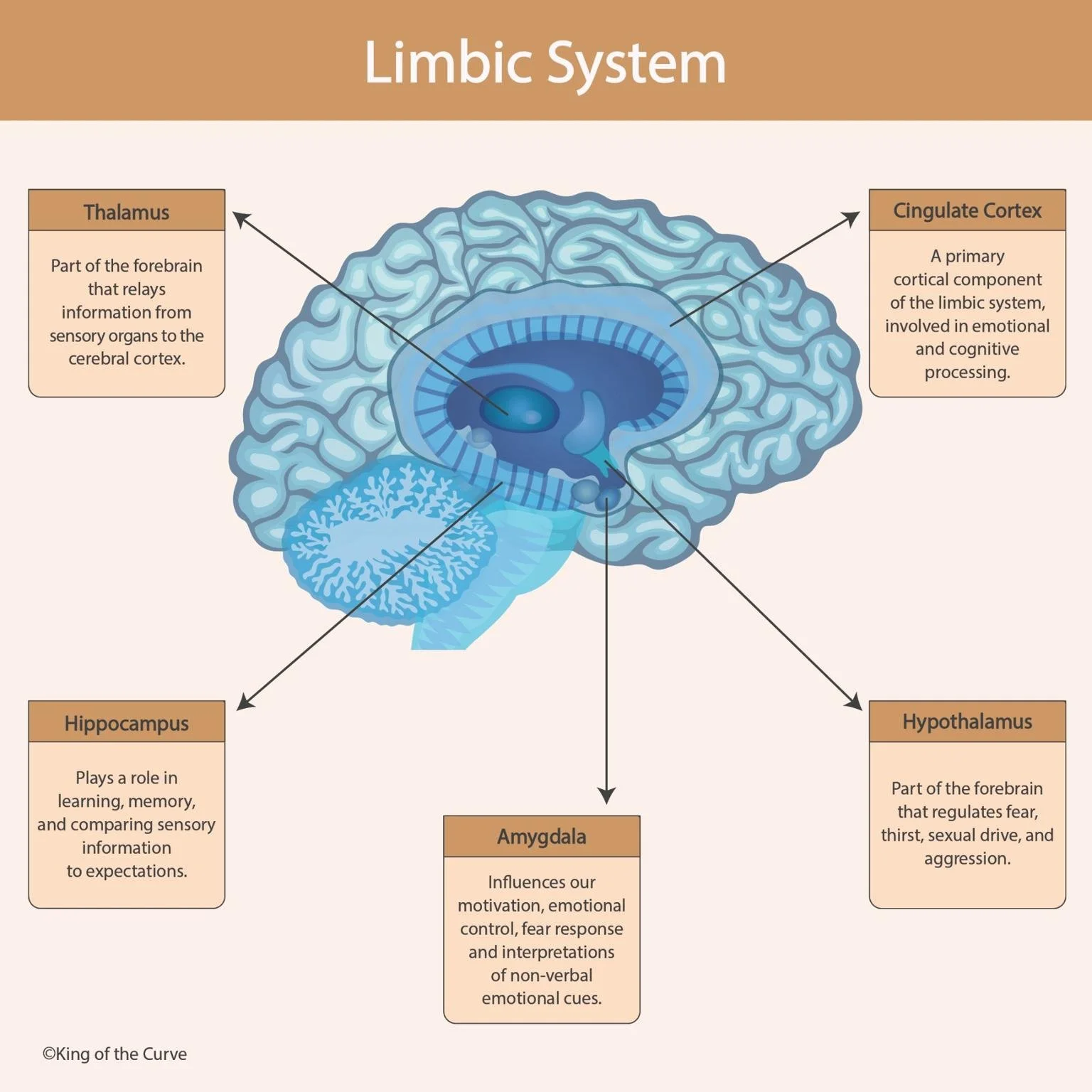🧠 Limbic System: The Emotional Core of the Brain
Emotions are at the heart of every human experience — from joy and motivation to fear and stress. But where do these feelings come from?
The answer lies in the Limbic System, a network of structures deep within the brain that connects emotion, memory, and motivation.
🔍 Major Components and Their Functions
🧩 1️⃣ Thalamus
Acts as the relay center of the brain.
Directs sensory information (except smell) to the cerebral cortex.
Plays a role in alertness and attention.
🧠 Exam Tip: On the MCAT, think of the thalamus as the brain’s “post office” — everything passes through it before being processed.
🧩 2️⃣ Hippocampus
Essential for learning and long-term memory consolidation.
Compares new sensory information to stored experiences and expectations.
Located in the temporal lobe.
💡 Clinical Connection: Damage to the hippocampus (e.g., in Alzheimer’s disease) leads to anterograde amnesia, where new memories can’t form.
🧩 3️⃣ Amygdala
The emotional processing hub of the brain.
Regulates fear, anger, and emotional reactions.
Integrates non-verbal emotional cues (like facial expressions).
⚕️ USMLE Insight: Overactivation of the amygdala is linked to anxiety disorders and PTSD.
🧩 4️⃣ Hypothalamus
Maintains homeostasis — regulating hunger, thirst, sexual drive, and temperature.
Controls the autonomic nervous system and the pituitary gland.
Links emotional responses to hormonal activity.
💡 Example: Stress activates the hypothalamus → triggers the HPA axis → releases cortisol.
🧩 5️⃣ Cingulate Cortex
A key cortical part of the limbic system.
Integrates emotional experiences with behavioral responses.
Involved in empathy, pain perception, and cognitive control.
🧩 Exam Tip: Dysfunction in this area can contribute to depression, OCD, and bipolar disorder.
📊 Quick Summary Table
| Structure | Primary Function | Clinical Relevance |
|---|---|---|
| Thalamus | Relays sensory information to the cerebral cortex. | Damage can cause sensory deficits or loss of consciousness. |
| Hippocampus | Responsible for memory formation and learning. | Degeneration leads to anterograde amnesia (as seen in Alzheimer’s disease). |
| Amygdala | Processes fear, emotion, and motivation. | Overactivity associated with anxiety and PTSD. |
| Hypothalamus | Maintains homeostasis and regulates hormonal responses. | Lesions can cause obesity, hormonal imbalance, and stress dysfunction. |
| Cingulate Cortex | Integrates emotional and cognitive processing. | Involved in mood and anxiety disorders. |
💡 MCAT Tip: Use the mnemonic HATCH — Hippocampus, Amygdala, Thalamus, Cingulate Cortex, Hypothalamus.
⚕️ Clinical & Behavioral Importance
1️⃣ Stress Response:
The amygdala activates the hypothalamus, initiating the fight-or-flight cascade.
2️⃣ Addiction & Reward Pathways:
The limbic system connects with the nucleus accumbens and ventral tegmental area (VTA) to release dopamine, reinforcing rewarding behaviors.
3️⃣ Emotional Memory:
The hippocampus and amygdala work together to store emotionally charged events — which is why emotional memories are often stronger.
4️⃣ Neuropsychiatric Disorders:
Depression: Reduced hippocampal volume.
PTSD: Hyperactive amygdala, underactive prefrontal regulation.
Schizophrenia: Thalamic and limbic dysfunction in sensory gating.
🧩 Exam Integration
MCAT: Neural pathways of emotion, stress physiology, and neurotransmission.
USMLE Step 1: Anatomy of brain structures, neuropsych disorders.
NCLEX: Patient behavior, stress management, and neuroanatomy fundamentals.
🌍 Beyond the Exam
Understanding the limbic system bridges science and psychology — revealing how our brains translate emotion into action.
Whether it’s empathy, motivation, or fear, these interconnected structures shape everything we do.
🔑 Call to Action
Master the brain’s emotional center with King of the Curve — the platform that makes neuroscience visual, simple, and engaging.
From adaptive learning to interactive diagrams, KOTC helps you study smarter and retain longer.
Frequently Asked Questions (FAQs)
-
Aim for 4-6 focused hours, ensuring you incorporate breaks to avoid burnout.
-
Practice mindfulness techniques, take practice exams under realistic conditions, and maintain a balanced lifestyle.
-
Set short-term goals, seek support from mentors, and reward yourself for small achievements.
-
Regular exercise improves focus, reduces stress, and enhances overall mental clarity.
-
KOTC offers personalized learning tools, gamification features, and adaptive question banks to help students stay on track without burnout.


